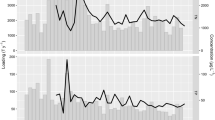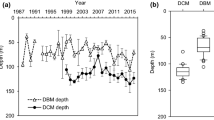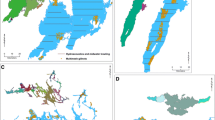Abstract
High-frequency measurements are increasingly available and used to model ecosystem processes. This growing capability provides the opportunity to resolve key drivers of ecosystem processes at a variety of scales. We use a unique series of high-frequency measures of potential predictors to analyze daily variation in rates of gross primary production (GPP), respiration (R), and net ecosystem production (NEP = GPP − R) for two north temperate lakes. Wind speed, temperature, light, precipitation, mixed layer depth, water column stability, chlorophyll a, chromophoric dissolved organic matter (CDOM), and zooplankton biomass were measured at daily or higher-frequency intervals over two summer seasons. We hypothesized that light, chlorophyll a, and zooplankton biomass would be strongly related to variability in GPP. We also hypothesized that chlorophyll a, CDOM, and temperature would be most strongly related to variability in R, whereas NEP would be related to variation in chlorophyll a and CDOM. Consistent with our hypotheses, chlorophyll a was among the most important drivers of GPP, R, and NEP in these systems. However, multiple regression models did not necessarily include the other variables we hypothesized as most important. Despite the large number of potential predictor variables, substantial variance remained unexplained and models were inconsistent between years and between lakes. Drivers of GPP, R, and NEP were difficult to resolve at daily time scales where strong seasonal dynamics were absent. More complex models with greater integration of physical processes are needed to better identify the underlying drivers of short-term variability of ecosystem processes in lakes and other systems.




Similar content being viewed by others
References
Baastrup-Spohr L, Staehr PA. 2009. Surface microlayers on temperate lowland lakes. Hydrobiologica 625:43–59.
Belzile C, Roesler CS, Christensen JP, Shakhova N, Semiletov I. 2006. Fluorescence measured using the WETStar DOM fluorometer as a proxy for dissolved matter absorption. Estuar Coast Shelf Sci 67:441–9.
Berg P, Roy H, Janssen F, Meyer V, Jorgensen BB, Hueffel M, de Beer D. 2003. Oxygen uptake by aquatic sediments measured with a novel non-invasive eddy-correlation technique. Mar Ecol Prog Ser 261:75–83.
Bott TL, Brock JT, Dunn CS, Naiman RJ, Ovink RW, Peterson RC. 1985. Benthic community metabolism in four temperate stream systems: an inter-biome comparison and evaluation of the river continuum concept. Hydrobiologia 123:3–45.
Bruce LC, Jellison R, Imberger J, Melack JM. 2008. Effect of benthic boundary layer transport on the productivity of Mono Lake, California. Saline Syst 4:11. doi:10.1186/1746-1448-4-11.
Carignan R, Bliss A-M, Vis C. 2000. Planktonic production and respiration in oligotrophic Shield lakes using the Winkler method. Can J Fish Aquat Sci 55:1078–84.
Carpenter SR, Kitchell JF, Eds. 1993. The trophic cascade in lakes. Cambridge: Cambridge University Press.
Carpenter SR, Cole JJ, Pace ML, Van de Bogert M, Bade DL, Bastviken D, Gille CM, Hodgson JR, Kitchell JF, Kritzberg ES. 2005. Ecosystem subsidies: terrestrial support of aquatic food webs from C-13 addition to contrasting lakes. Ecology 86:2737–50.
Cole JJ, Caraco NF. 1998. Atmospheric exchange of carbon dioxide in a low-wind oligotrophic lake measured by the addition of SF6. Limnol Oceanogr 43:647–56.
Cole JJ, Pace ML, Carpenter SR, Kitchell JF. 2000. Persistence of net heterotrophy in lakes during nutrient addition and food web manipulations. Limnol Oceanogr 45:1718–30.
Coloso JJ, Cole JJ, Hanson PC, Pace ML. 2008. Depth-integrated, continuous estimates of metabolism in a clear-water lake. Can J Fish Aquat Sci 65:712–22.
Coloso JJ, Cole JJ, Pace ML. 2011. Short-term variation in thermal stratification complicates estimation of lake metabolism. Aquat Sci 73:305–15. doi:10.1007/s00027-010-0177-0.
Dodds WK, Cole JJ. 2007. Expanding the concept of trophic state in aquatic ecosystems: it’s not just the autotrophs. Aquat Sci 69:427–39.
Eckert WJ, Imberger J, Saggio A. 2002. Biogeochemical response to physical forcing in the water column of a warm monomictic lake. Biogeochemistry 61:291–307.
Gelda RK, Effler SW. 2002. Metabolic rate estimates for a eutrophic lake from diel dissolved oxygen signals. Hydrobiologia 485:51–66.
Goodwin K, Caraco N, Cole J. 2008. Temporal dynamics of dissolved oxygen in a floating-leaved macrophyte bed. Freshwater Biol 53:1632–41.
Hagerthey SE, Cole JJ, Kilbane D. 2010. Aquatic metabolism in the everglades: dominance of water column heterotrophy. Limnol Oceanogr 55:653–66.
Hanson PC. 2008. New ecological insights through the Global Lake Ecological Observatory Network (GLEON). Ecol Sci 27:300–2.
Hanson PC, Bade DL, Carpenter SR, Kratz TK. 2003. Lake metabolism: relationships with dissolved organic carbon and phosphorus. Limnol Oceanogr 48:1112–19.
Hanson PC, Carpenter SR, Kimura N, Chin W, Cornelius SP, Kratz TK. 2008. Evaluation of metabolism models for free-water dissolved oxygen methods in lakes. Limnol Oceanogr Methods 6:454–65.
Holm-Hansen O, Rieman B. 1978. Chlorophyll a determination: improvement in methodology. Oikos 30:438–47.
Jahne B, Munnich KO, Bosinger R, Dutzi A, Huber W, Libner P. 1987. On the parameters influencing air-water gas-exchange. J Geophys Res 92:1937–49.
Janke SJ, Tinsley F. 2005. Introduction to linear models and statistical inference. Hoboken: Wiley-Interscience.
Kalff J. 2002. Limnology: inland water ecosystems. Upper Saddle River, NJ: Prentice-Hall.
Keller M, Schimel DS, Hargrove WM, Hoffman FM. 2008. A continental strategy for the National Ecological Observatory Network. Front Ecol Environ 6:282–4.
Knauss JA. 1997. Introduction to physical oceanography. Upper Saddle River, NJ: Prentice-Hall.
Kutner MH, Nachtsheim CJ, Netter J. 2005. Applied linear statistical models. Boston, MA: McGraw-Hill.
Langman OC, Hanson PC, Carpenter SR, Chiu K, Hu YH. 2010. Control of dissolved oxygen in northern temperate lakes over scales ranging from minutes to days. Aquat Biol 9:193–202.
Lasslop G, Reichstein M, Papale D, Richardson AD, Arneth A, Barr A, Stoy P, Wohlfahrt G. 2010. Separation of net ecosystem exchange into assimilation and respiration using a light response curve approach: critical issues and global evaluation. Glob Change Biol 16:187–208.
Lauster GH, Hanson PC, Kratz TK. 2006. Gross primary production and respiration differences among littoral and pelagic habitats in northern Wisconsin lakes. Can J Fish Aquat Sci 63:1130–41.
MacIntyre S, Sickman JO, Goldthwait SA, Kling GW. 2006. Physical pathways of nutrient supply in a small, ultraoligotrophic arctic lake during summer stratification. Limnol Oceanogr 51:1107–24.
MacIntyre S, Jonsson A, Jansson M, Aberg J, Turney DE, Miller S. 2010. Buoyancy flux, turbulence, and the gas transfer coefficient in a stratified lake. Geophys Res Lett (in press).
Marker AFH, Crowther CA, Gunn RJM. 1980. Methanol and acetone as solvents for estimating chlorophyll a and phaeopigments by spectrophotometry. Ergebnisse der Limnologie 14:52–69.
McIntire CD, Garrison RL, Phinney HK, Warren CE. 1964. Primary production in laboratory streams. Limnol Oceanogr 9:92–102.
Odum HT. 1956. Primary production in flowing waters. Limnol Oceanogr 1:102–17.
Ostrovsky I, Yacobi YZ, Walline P, Kalikhman I. 1996. Seiche-induced mixing: its impact on lake productivity. Limnol Oceanogr 41:323–32.
Pace ML, Prairie YT. 2005. Respiration in lakes. In: del Giorgio PA, Williams PJLB, Eds. Respiration in aquatic ecosystems. Oxford: Oxford University Press. p 103–21.
Parkhill JP, Maillet G, Cullen JJ. 2001. Fluorescence-based maximal quantum yield for PSII as a diagnostic of nutrient stress. J Phycol 37:517–29.
Petersen JE, Chen CC, Kemp WM. 1997. Scaling aquatic primary productivity: experiments under nutrient- and light-limited conditions. Ecology 78:2326–38.
Porter JH, Nagy E, Kratz TK, Hanson P, Collins SL, Arzberger P. 2009. New eyes on the world: advanced sensors in ecology. BioScience 59:386–97.
Sand-Jensen K, Staehr PA. 2007. Scaling of pelagic metabolism to size, trophy and forest cover in small Danish lakes. Ecosystems 10:127–41.
Sheather SJ. 2009. A modern approach to regression with R. New York: Springer.
Staehr P, Sand-Jensen K. 2007. Temporal dynamics and regulation of lake metabolism. Limnol Oceanogr 52:108–20.
Staehr PA, Bade D, Van de Bogert MC, Koch GR, Williamson C, Hanson P, Cole JJ, Kratz T. 2010a. Lake metabolism and the diel oxygen technique: State of the science. Limnol Oceanogr Methods 8:628–44.
Staehr PA, Sand-Jensen K, Raun AL, Nilsson B, Kidmosec J. 2010b. Drivers of metabolism and net heterotrophy in contrasting lakes. Limnol Oceanogr 55:817–30.
Tsai J, Kratz TK, Hanson PC, Wu J, Chang WYB, Arzberger PW, Lin B, Lin F, Chou H, Chiu C. 2008. Seasonal dynamics, typhoons and the regulation of lake metabolism in a subtropical humic lake. Freshwater Biol 53:1929–41.
Vadeboncoeur Y, Vander Zanden MJ, Lodge DM. 2002. Putting the lake back together: reintegrating benthic pathways into lake food web models. Bioscience 52:44–54.
Vadeboncoeur Y, Peterson G, Vander Zanden MJ, Kalff J. 2008. Benthic algal production across lake size gradients: interactions among morphometry, nutrients, and light. Ecology 89:2542–52.
Van de Bogert MC, Carpenter SR, Cole JJ, Pace ML. 2007. Assessing pelagic and benthic metabolism using free water measurements. Limnol Oceanogr Methods 5:145–55.
Acknowledgments
This work was funded by a grant from the National Science Foundation (DEB-0829583). We acknowledge the staff at the University of Notre Dame Environmental Research Center for facilitating this research. We thank Steve Carpenter for his advice on data analysis, Laura Smith for assisting with sondes, and the entire Cascade Crew for their efforts collecting daily data. Matt Reidenbach, Karen McGlathery, and four anonymous reviewers provided suggestions on earlier versions of this manuscript.
Author information
Authors and Affiliations
Corresponding author
Additional information
Author Contributions
James Coloso conceived of and designed the study, performed the research, analyzed the data, and wrote the paper. Jonathan Cole conceived of and designed the study, and provided editorial input to the paper. Michael Pace conceived of and designed the study, and provided editorial input to the paper.
Electronic supplementary material
Below is the link to the electronic supplementary material.
Rights and permissions
About this article
Cite this article
Coloso, J.J., Cole, J.J. & Pace, M.L. Difficulty in Discerning Drivers of Lake Ecosystem Metabolism with High-Frequency Data. Ecosystems 14, 935–948 (2011). https://doi.org/10.1007/s10021-011-9455-5
Received:
Accepted:
Published:
Issue Date:
DOI: https://doi.org/10.1007/s10021-011-9455-5




